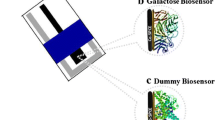Abstract
We report a novel and convenient method for the determination of glycoproteins, especially antibodies, using galactose oxidase (GAO) on the basis of the contents of galactosyl and N-acetylgalactosaminyl residues in carbohydrate chains of glycoproteins. GAO converts galactose residues to their corresponding aldehyde and H2O2, the latter being electroactive and quantifiable by DC amperometry. The method does not require processes such as antibody labeling or the use of enzyme-tagged secondary antibodies. For an array-type immunosensing, the platform surface for antigen immobilization was specially designed by using differentiated surface wetting property of hydrophobic and hydrophilic patterns. We patterned the hydrophobic surface of the poly(dimethylsiloxane) substrate by microcontact printing with the poly(amidoamine) dendrimer ink, providing hydrophilic patterns on a hydrophobic base substrate. By applying aqueous solution on the patterned surface, an array of free-standing water droplets was made. With the prepared virtual beaker array, electrochemical immunosensing was performed by using anti-dinitrophenyl-IgG as a model target protein. From immunoassay with GAO-mediated electrocatalysis, a good correlation in amperometric signal with the target IgG was registered. The total assay time was about 20 min, including antibody recognition and signal registration.
Similar content being viewed by others
References
Hongwei L, Deajoon K, Mark GB, Wilhelm TSH (2002) High-resolution contact printing with dendrimers. Nano Letts 2:347–349
Hong MY, Yoon HC, Kim HS (2003) Protein–ligand interactions at poly(amidoamine) dendrimer monolayers on gold. Langmuir 19:416–421
Hughes RC (1983) Glycoproteins. In: Outline studies in biology. Chapman and Hall, London, UK, pp 15–22
Joydeep L, Emanuele O, George MW (1999) Patterning ligands on reactive SAMs by microcontact printing. Langmuir 15:2055–2060
Kojima K, Hiratsuka A, Suzuki H, Yano K, Ikebukuro K, Karube I (2003) Electrochemical protein chip with arrayed immunosensors with antibodies immobilized in a plasma-polymerized film. Anal Chem 75:1116–1122
Sato K, Yamanaka M, Takahashi H, Kimura H, Kitamori T (2002) Microchip-based immunoassay system with branching multichannels for simultaneous detection of interferon-γ. Electrophoresis 23:734–739
Silverstein AM (2004) Labeled antigens and antibodies: The evolution of magic markers and magic bullets. Nature Immunol 5:1211–1217
Templin MF, Stoll D, Schwenk JM, Potz O, Kramer S, Joos TO (2003) Protein microarrays: Promising tools for proteomic research. Proteomics 3:2155–2166
Tkac J, Vostiar I, Gemeiner P, Sturdik E (2002) Indirect evidence of direct electron communication between the active site of galactose oxidase and a graphite electrode. Bioelectrochemistry 56:23–25
Xia YN, Whitesides GM (1998) Soft lithography. Annu Rev Mater Sci 28:153–184
Yi DK, Kim MJ, Turner L, Breuer KS, Kim DY (2006) Colloid lithography-induced polydimethylsiloxane microstructures and their application to cell patterning. Biotechnol Lett 28:169–173
Yoon HC, Yang H, Kim YT (2002) Biocatalytic precipitation induced by an affinity reaction on dendrimer-activated surfaces for the electrochemical signaling from immunosensors. Analyst 127:1082–1087
Acknowledgement
This research was supported by the Korea Research Foundation grant (R05-2004-000-10209-0) funded by the Korean government (MOEHRD).
Author information
Authors and Affiliations
Corresponding author
Rights and permissions
About this article
Cite this article
Jeon, S.I., Hong, J.W. & Yoon, H.C. A new immunosensing method by galactose oxidase-mediated electrocatalysis using a virtual beaker array. Biotechnol Lett 28, 1401–1408 (2006). https://doi.org/10.1007/s10529-006-9102-y
Received:
Accepted:
Published:
Issue Date:
DOI: https://doi.org/10.1007/s10529-006-9102-y




